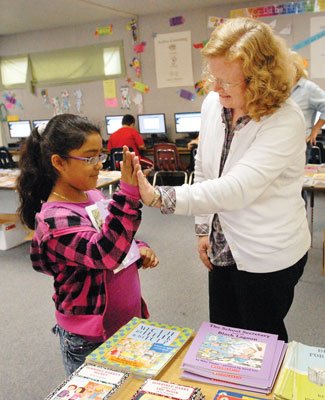Though many school campuses stand silent during the summer
months, the technology center at Glen View Elementary School is a
bustling hub of activity.
Though many school campuses stand silent during the summer months, the technology center at Glen View Elementary School is a bustling hub of activity.
Every Wednesday, parents form a line outside, some flipping absentmindedly through children’s books to entertain themselves, others quietly thumbing through picture books with their toddlers.
Inside, Glen View students take a quick test on the computer then, if they do well, spend a few minutes poring over a vast selection of books before finally selecting the one they will take home with them for the week.
Volunteer teachers circulate, making suggestions and helping students make crucial reading selections as part of a program to deal with an alarming trend: Students that don’t read in the summer fall behind, students that do jump as many as two grade levels over the summer.
“Summer can be very bad for kids if they don’t keep up with their reading and spelling,” said Maureen Clark, a second grade teacher at Glen View. “I watch it every year. If there’s no reading over the summer, it takes a month to get them back to where they were at the end of last year.”
In its second year, the Glen View Summer Reading Program was created to reverse the pattern of learning loss and it seems to be catching on.
Attendance has doubled from last year, drawing more than 100 students every week.
With almost 90 percent of its students enrolled in the free and reduced lunch program, Glen View is the second neediest elementary school in the district, said second grade teacher Benita Wilson, who came up with the idea for the program.
On top of that, more than half the children at the school are classified as English learners.
“Most of our students aren’t reading at grade level when they land in our classrooms,” she said “The summer break may be one of the greatest factors in the persistent achievement gap with high needs students losing as much as two months of learning each summer.”
The concept is straightforward, said Wilson.
At the end of last school year, each Glen View student left for the summer with an on-level book and registration form in hand. Of Glen View’s approximately 600 students, 175 registered for the program and about 110 show up faithfully, Wilson said.
Every Wednesday, volunteer teachers open up the technology center for two hours and students sign up to take an electronic test on their book.
If they pass with more than an 80 percent, they get to keep their book and pick up a new one for the week. If they don’t, they can swap their book out for another or reread the book they have. If a student comes every week and passes the test, the student can earn 10 books by summer’s end.
“There’s a simpleness to it,” Wilson said with a smile.
Even though teachers are giving up several hours of their summer vacation every week to run the program, they’re happy to do it, they said.
Low-income children don’t always have the opportunities to travel or participate in enriching activities and the program provides books to read during the summer that they otherwise wouldn’t have, teachers said. It is a way to help students who have struggled with reading even during the school year, they said.
Her arms laden with books, 7-year-old Alyana Jimenez furrowed her brow when trying to decide between “The Magic School Bus” and “Pajama Llama.” Though her mother often reads to her, they’ve swapped roles recently and Alyana is getting better at reading out loud to her mother.
“My oldest surprises me sometimes,” said her mother Teresa Jimenez, whose three daughters attend Glen View. “When they take the test and do well, it makes them feel great and want to read even more.”
The idea for the reading program hatched at the classroom level, when Wilson was searching for a way to combine the school’s technology with an exciting reason to keep students reading. After tossing some ideas around with her second grade team, the Summer Reading Program took shape. With a $1,000 grant from the Gilroy Rotary, book fairs and the Home and School Club’s fundraising efforts, Glen View purchased 880 books this summer.
“A lot of work with the program starts with the classroom teacher,” Wilson said. “There’s an excitement that feeds on itself.”
The grassroots effort to get books into the hands of students and build a culture of reading beyond the classroom may be “the best kept secret in Gilroy,” said Gondie Chavez, a first grade teacher at Glen View.
Every Tuesday evening, parents receive an automated reminder phone call from the school. Though about 30 percent of her students attend the program regularly, Wilson said she wants to see 100 percent.
Lea Legnon brings her son Tyler every Wednesday and said she would rather invest a little bit of time every day into her son’s reading skills than fight with him over homework when school starts up again.
“This way, we’re not playing catch up,” she said. “If kids aren’t utilizing their reading skills, they’re going to lose them. We’re trying to keep his study habits at the same level over the summer. If we don’t, the first couple months back are a struggle. To apply consistently every day pays off in the long run.”















